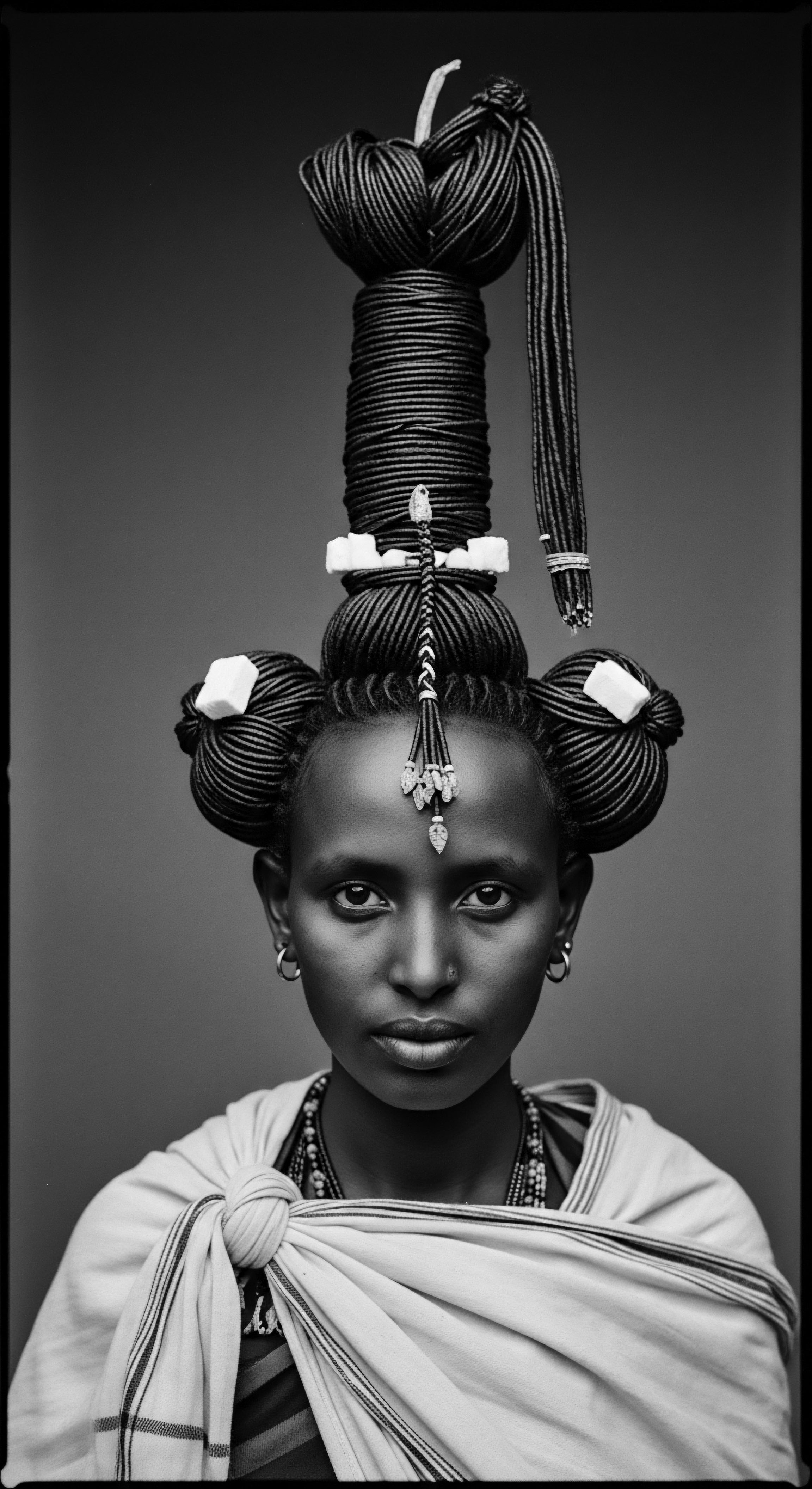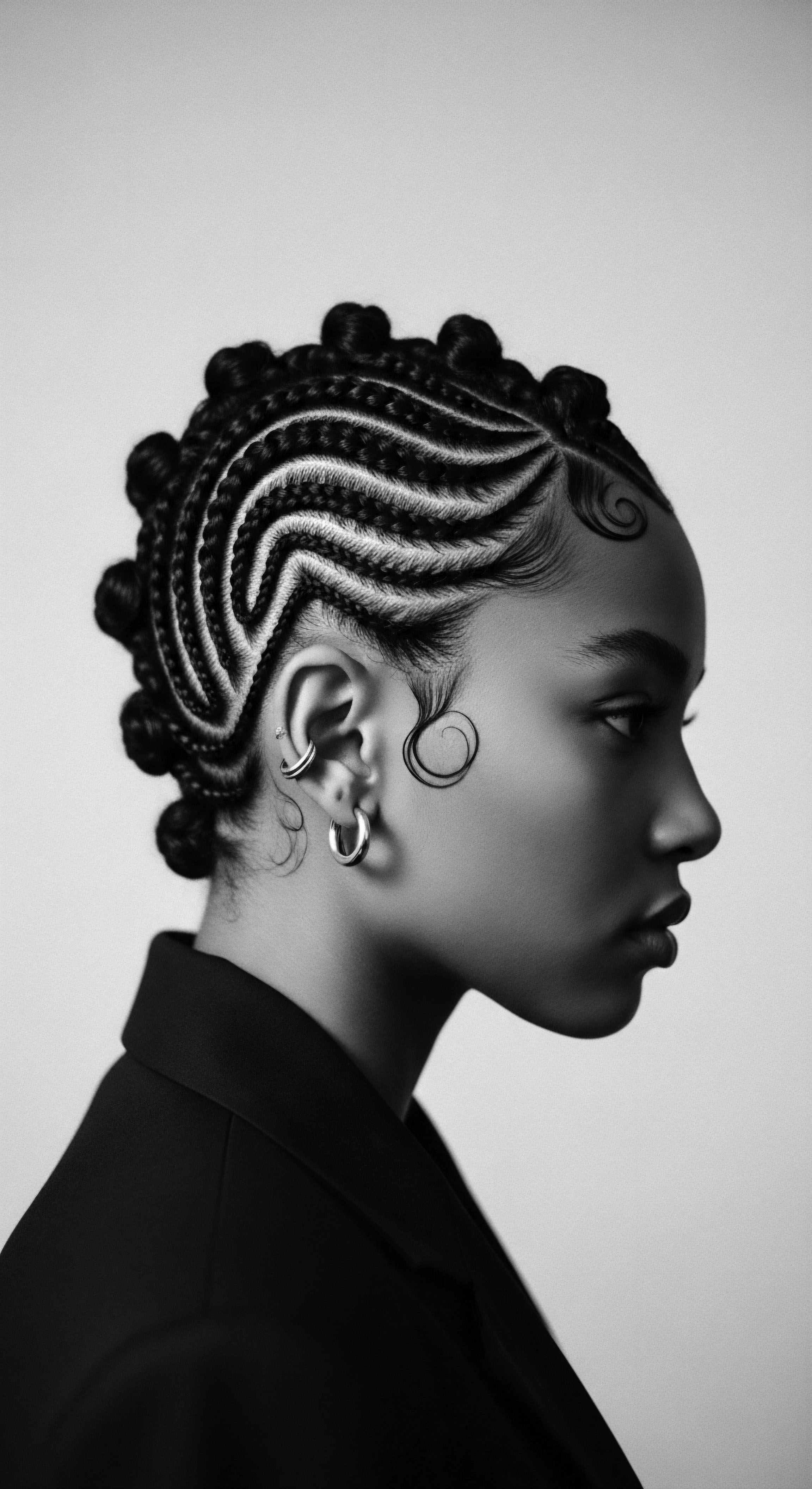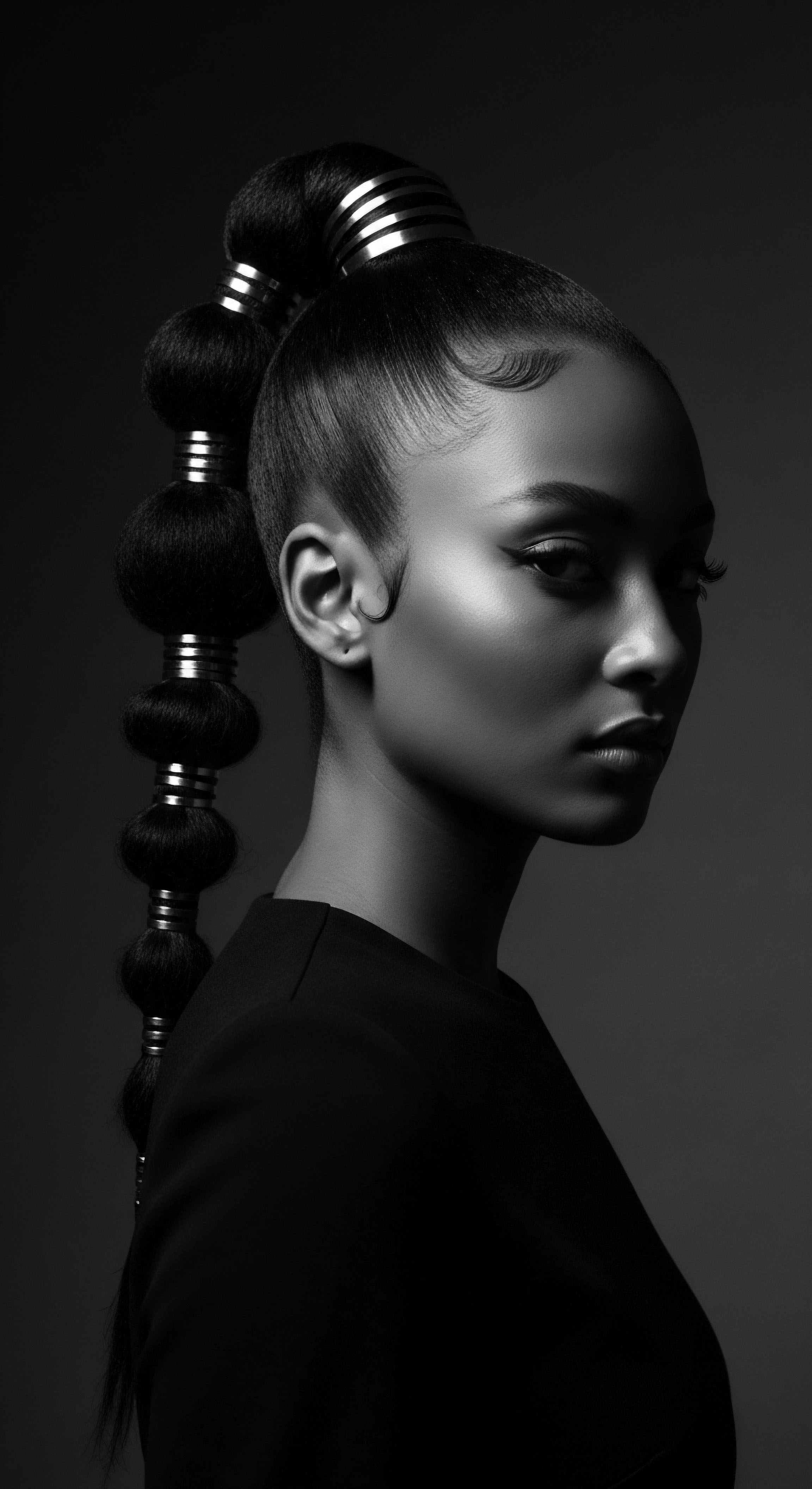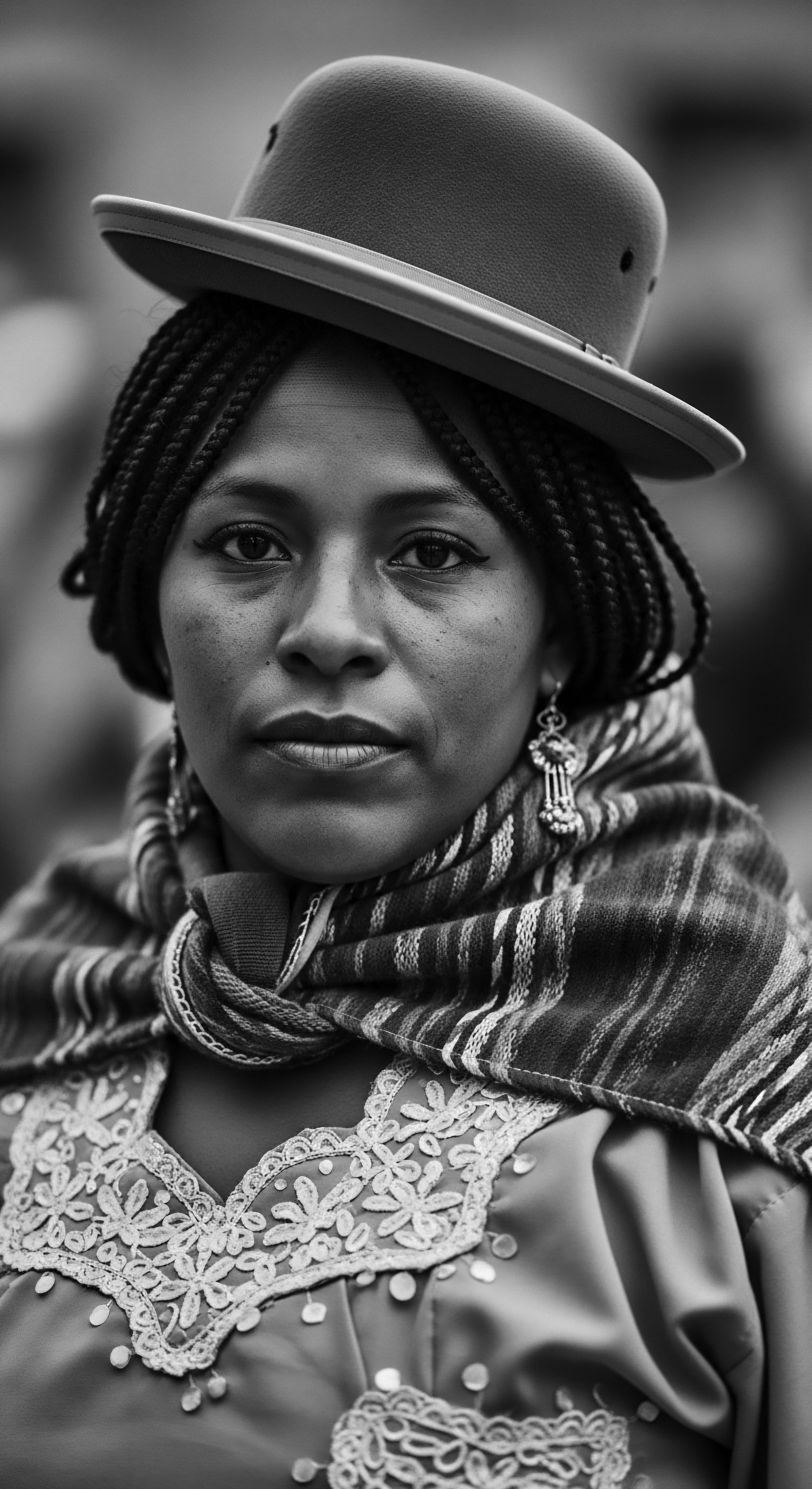
Fundamentals
The narrative of Shea Butter, a cherished gift from the Vitellaria Paradoxa tree, commences not in a laboratory, but in the sun-drenched savannas of West Africa. Its fundamental meaning, as a substance of profound utility and spiritual resonance, was first etched into the collective memory of ancestral communities across the vast ‘Shea Belt’—a crescent of land stretching from Senegal to Uganda. This golden balm, often called ‘karité’ in some regions, transcends mere cosmetic application; its initial understanding was deeply interwoven with daily sustenance, traditional medicine, and the sacred rituals that defined communal existence. The designation of Shea Butter as a vital resource speaks to its enduring presence in the lives of generations, a testament to its multifaceted utility and the wisdom of those who first discerned its properties.
From its very genesis, the extraction of Shea Butter has been a process steeped in communal practice and generational wisdom, primarily orchestrated by women. The careful gathering of the fallen Shea fruits, a practice respecting the tree’s natural cycle, marks the commencement of a meticulous transformation. The fruits’ pulp is removed, revealing the nuts, which are then boiled, sun-dried, and cracked to yield the inner kernels. These kernels undergo a series of labor-intensive steps ❉ roasting, grinding into a paste, and then kneading with water until the rich oils separate.
This traditional method, passed down through oral traditions and hands-on teaching, is not merely a technical procedure; it represents a living heritage, a shared knowledge system that honors the land and its bounty. The very essence of Shea Butter, therefore, carries the echoes of these ancient hands, their songs, and their collective labor.
The earliest historical contexts reveal Shea Butter as a foundational element in ancestral wellness. Its use spanned dietary needs, where its fats provided essential nourishment, to a revered balm for the skin, offering protection against the harsh savanna sun and relief from minor ailments. For textured hair, particularly within Black and mixed-race communities, Shea Butter’s significance was recognized long before modern science articulated its molecular structure. It served as a potent emollient, a protective shield against environmental stressors, and a medium for intricate hair artistry.
This primary explication of Shea Butter positions it not just as an ingredient, but as a cultural cornerstone, a natural endowment whose practical applications shaped the daily lives and aesthetic expressions of diverse African societies. The clarity of its initial role, grounded in holistic well-being, provides a lens through which to comprehend its enduring legacy.
Shea Butter’s earliest significance arose from its integral role in West African ancestral life, extending beyond simple utility to embody communal sustenance, healing, and cultural expression.

The Ancestral Harvest and Processing
The harvest of Shea nuts, typically occurring between May and August, aligns with the rhythms of the rainy season, a period of renewal for the land. This timing is not arbitrary; it speaks to a deep understanding of ecological cycles, ensuring sustainability through generations. The process of turning the nuts into butter, a tradition often performed by women, is a ritualistic dance of patience and precision. The kernels, once extracted, are crushed and roasted, a step that imparts a distinct aroma and helps release the butter.
Subsequent grinding creates a thick, dark paste, which is then vigorously kneaded, sometimes for hours, while gradually adding water. This churning action causes the fats to separate, floating to the surface as a creamy, golden substance.
The water is then carefully decanted, and the remaining butter is melted, filtered, and allowed to cool and solidify. This traditional artisanal method, though labor-intensive, preserves the maximum beneficial properties of the Shea Butter, retaining its unique unsaponifiable matter, which modern refining processes often diminish. The delineation of this ancestral process highlights a profound respect for the ingredient, recognizing that its true value lies not just in its end product, but in the very hands that guide its creation, linking present-day users to a timeless chain of knowledge.

Early Cultural Designations and Hair Rituals
Across various West African ethnic groups, Shea Butter held distinct designations and applications. Among the Dagomba People of Ghana, for instance, it is known as ‘nkuto,’ and its usage in hair care is deeply embedded in rites of passage and daily grooming. For newborns, a gentle application of Shea Butter to the scalp was believed to promote healthy hair growth and provide protection.
As children grew, it became a regular part of detangling and moisturizing textured strands, preventing breakage and imparting a natural luster. This practical application was simultaneously a cultural statement, a way of affirming connection to ancestral practices and reinforcing communal bonds through shared care rituals.
The interpretation of Shea Butter’s significance extends to its role in ceremonial hair styling. Elaborate braided patterns, often adorned with cowrie shells or beads, were prepared with Shea Butter to provide slip, reduce friction, and keep the hair supple. These styles were not merely aesthetic choices; they served as visual markers of identity, status, and tribal affiliation. The statement of Shea Butter’s importance in these contexts is therefore one of profound cultural integration, where a natural ingredient becomes an indispensable tool for expressing heritage and belonging.
- Hair Moisturization ❉ Traditional uses of Shea Butter consistently centered on its capacity to seal moisture into textured hair, preventing dryness and brittleness.
- Scalp Health ❉ Ancestral wisdom recognized its soothing properties for the scalp, addressing irritation and promoting a healthy environment for hair growth.
- Protective Styling ❉ Shea Butter was essential for preparing hair for protective styles like braids and twists, reducing tension and adding pliability to strands.
- Post-Partum Care ❉ In some communities, it was applied to new mothers’ hair and scalps to aid in recovery and hair restoration.

Intermediate
Moving beyond its foundational understanding, the intermediate meaning of Shea Butter for textured hair illuminates how its heritage practices have not only persisted but also adapted across continents and generations. This section focuses on the practical applications within traditional and evolving hair care rituals for Black and mixed-race hair, emphasizing the continuity and resilience of knowledge related to this golden balm. The significance of Shea Butter, in this context, lies in its enduring role as a primary agent of care, protection, and cultural continuity, a tender thread connecting ancestral wisdom to contemporary needs. Its consistent presence in the routines of textured hair care speaks to a profound understanding of its properties, an understanding cultivated over centuries and refined through lived experience.
The diaspora’s journey saw Shea Butter, sometimes directly, sometimes through adapted knowledge of its properties, maintaining its standing as a cornerstone of hair wellness. Enslaved Africans, stripped of many material possessions, carried with them the invaluable knowledge of natural ingredients and their applications. While direct access to Shea Butter might have been limited in the Americas, the ancestral memory of its moisturizing and protective qualities influenced the utilization of other available plant-based fats and oils.
Upon its reintroduction or more widespread availability, Shea Butter seamlessly re-integrated into hair care practices, its efficacy for coiled, kinky, and wavy textures affirming its deep ancestral roots. The implication here is a resilient transfer of knowledge, a testament to the adaptive spirit of Black and mixed-race communities in preserving their hair heritage.
This evolving relationship with Shea Butter saw its application in more specific ways, moving from a general balm to a targeted treatment for the unique requirements of textured hair. Its ability to create a protective barrier on the hair shaft, reducing moisture loss and environmental damage, became particularly valuable. The substance of Shea Butter, with its rich fatty acid profile, was understood, through observation and inherited wisdom, to be a superior conditioner for hair prone to dryness and breakage. This practical explication reveals a deeper layer of its meaning, one that speaks to active problem-solving within the context of hair health and resilience.
Shea Butter’s intermediate significance resides in its consistent role as a resilient, adaptive agent of care and cultural continuity for textured hair across the diaspora.

The Tender Thread ❉ Shea Butter in Diasporic Hair Care
The journey of Shea Butter’s knowledge across the Atlantic, even when the physical product was scarce, represents a powerful act of cultural preservation. The ancestral understanding of its emollients and protective qualities informed the search for and use of similar local alternatives in the Americas and the Caribbean. When Shea Butter became more accessible through trade routes, its re-adoption was not merely a discovery; it was a homecoming for a revered ingredient.
This period solidified its designation as a staple for textured hair, used for everything from pre-shampoo treatments to daily styling. The sense of continuity it provided, connecting individuals to practices that spanned generations and geographies, contributed significantly to its enduring appeal.
Consider the mid-20th century, a period marked by both assimilationist pressures and burgeoning movements for Black pride. Within this complex social landscape, the choice to use natural ingredients like Shea Butter for hair care became a quiet, yet potent, act of self-affirmation. It was a rejection of chemical relaxers and a return to practices that honored the inherent beauty and structure of textured hair. The intention behind its use shifted from mere maintenance to a conscious declaration of identity and a connection to ancestral wisdom.

Adapting Traditional Practices ❉ From Hearth to Home
The application methods for Shea Butter also evolved, adapting to new environments and lifestyles while retaining their core principles. Traditional West African communities often applied raw, unrefined Shea Butter directly, sometimes warmed gently to enhance its spreadability. In diasporic homes, this evolved into practices like “greasing the scalp” or using it as a foundational ingredient in homemade hair concoctions.
These adaptations, while perhaps less ceremonial than their African counterparts, still carried the weight of inherited knowledge and communal sharing. The meaning of these rituals extended beyond the physical act; they were moments of bonding, intergenerational teaching, and the quiet affirmation of cultural identity.
A specific historical example of this adaptation can be observed in the practices of Black American Women in the Early 20th Century. As documented by historians of Black beauty culture, while commercial products began to emerge, many families continued to rely on traditional remedies for hair care, often passed down from grandmothers and mothers. Shea Butter, or its perceived properties, informed the use of other natural fats like lard or petroleum jelly in a pinch, demonstrating a deep understanding of what textured hair needed for moisture and protection, even when the exact ancestral ingredient was unavailable.
This period showcases the adaptive spirit of heritage, ensuring that the purpose of ancestral care endured, even if the precise form had to shift. The elucidation of this adaptive journey highlights the resilience of Black hair care traditions.
| Traditional West African Practices Direct Application ❉ Raw, unrefined Shea Butter, often warmed, applied directly to hair and scalp. |
| Diasporic Adaptations (e.g. Early 20th Century Americas) "Greasing the Scalp" ❉ Use of Shea Butter or similar emollients as a foundational scalp treatment, sometimes mixed with other oils. |
| Traditional West African Practices Ceremonial Grooming ❉ Integral to rites of passage, pre-braiding rituals, and communal hair styling. |
| Diasporic Adaptations (e.g. Early 20th Century Americas) Daily Hair Dressing ❉ Applied as a sealant after washing, for daily moisture, or to prepare hair for twists and braids in domestic settings. |
| Traditional West African Practices Community-Based Production ❉ Women's cooperatives producing Shea Butter for local consumption and trade. |
| Diasporic Adaptations (e.g. Early 20th Century Americas) Individual/Family Sourcing ❉ Reliance on imported Shea Butter or its principles applied to locally available fats; emergence of small-scale home-based formulations. |
| Traditional West African Practices The enduring significance of Shea Butter lies in its capacity to bridge ancestral wisdom with evolving care practices across diverse Black and mixed-race communities. |

Academic
The advanced understanding of Shea Butter, particularly within the context of textured hair, Black hair, and mixed-race hair heritage, demands a synthesis of scientific rigor, anthropological insight, and historical consciousness. Its definition, at this sophisticated level, transcends simple explanation to become a profound inquiry into its biological composition, its role in cultural resistance, and its implications for future wellness paradigms. The meaning of Shea Butter, from an expert perspective, is not static; it is a dynamic intersection where elemental biology meets ancestral wisdom, where historical struggle finds expression in self-care, and where contemporary science validates time-honored practices. This academic delineation provides a compound, deeply insightful explication of Shea Butter’s full significance, offering maximum insight for researchers, industry professionals, and those seeking a scholarly understanding of its enduring impact.
Scientifically, Shea Butter is a complex lipid matrix, predominantly composed of fatty acids such as Oleic Acid (a monounsaturated omega-9 fatty acid), Stearic Acid (a saturated fatty acid), and lesser amounts of linoleic acid, palmitic acid, and arachidic acid. What distinguishes Shea Butter and contributes significantly to its efficacy for textured hair is its remarkably high content of unsaponifiable matter, ranging from 5% to 17% (Maranz et al. 2004). This unsaponifiable fraction includes beneficial compounds like triterpenes (e.g.
lupeol, amyrin), tocopherols (Vitamin E), phytosterols (e.g. beta-sitosterol, stigmasterol), and karitenes. These compounds are responsible for many of Shea Butter’s documented anti-inflammatory, antioxidant, and UV-protective properties, which ancestrally were observed as its soothing and protective qualities for skin and hair. The clarification of these biochemical components provides a scientific underpinning for the traditional understanding of Shea Butter’s efficacy in maintaining the integrity and health of textured strands.
From an anthropological standpoint, Shea Butter is more than a commodity; it is a symbol of women’s economic autonomy and a conduit of intergenerational knowledge. In many West African societies, the production and trade of Shea Butter have historically been, and continue to be, a primary source of income for women. This economic empowerment is not merely financial; it represents a continuation of ancestral roles, where women were often the custodians of botanical knowledge and community well-being.
The interpretation of Shea Butter’s role here speaks to its deep connection to social structures, gender dynamics, and the preservation of traditional livelihoods. Its purport extends to the very fabric of community resilience.
Shea Butter’s advanced significance is found in its scientific composition validating ancestral wisdom, its anthropological role in women’s economic autonomy, and its historical function in cultural resistance.

The Unbound Helix ❉ Shea Butter as a Symbol of Resilience and Identity
The profound connection between Shea Butter and textured hair heritage extends into the realm of identity and resistance, particularly within the context of the African diaspora. During periods of immense cultural suppression, such as the transatlantic slave trade and subsequent eras of systemic oppression, hair became a powerful site of self-expression and defiance. The use of natural ingredients like Shea Butter, when available, for maintaining and styling hair, was a quiet yet potent act of reclaiming autonomy over one’s body and cultural practices.
It was a way of holding onto ancestral traditions, a silent statement against the forced erasure of identity. The connotation of Shea Butter in this historical context is therefore one of profound resilience, a substance that helped Black and mixed-race individuals maintain a tangible link to their origins and express their inherent beauty.
Consider the Negritude Movement of the mid-20th century, which celebrated Black identity and culture. This intellectual and artistic movement often championed natural hair as a symbol of pride and a rejection of Eurocentric beauty standards. Within this awakening, Shea Butter, alongside other natural oils and butters, gained renewed prominence.
Its practical application in maintaining natural hair styles became intertwined with a broader philosophical stance on self-acceptance and cultural affirmation. The substance of Shea Butter thus contributed to a larger societal shift, becoming an agent in the ongoing dialogue about beauty, race, and self-determination.

Future Trajectories ❉ Heritage-Informed Innovation
The academic examination of Shea Butter also looks towards its future, considering how its deep heritage can inform sustainable innovation. As global demand for natural ingredients grows, there is a critical need to ensure that the increased commercialization of Shea Butter benefits the communities that have historically cultivated and processed it. This requires a nuanced understanding of traditional harvesting and processing methods, promoting fair trade practices, and supporting women’s cooperatives in West Africa.
The long-term consequences of unsustainable sourcing could undermine the very heritage that gives Shea Butter its profound value. Therefore, any contemporary application or business model must be grounded in ethical considerations that honor its ancestral roots.
Furthermore, advanced research into the specific compounds within Shea Butter and their interactions with textured hair can lead to more targeted and effective hair care solutions that respect the unique biology of Black and mixed-race hair. This is not about reinventing the wheel, but rather using modern scientific tools to deepen our understanding of ancestral practices. The essence of this approach lies in a collaborative dialogue between traditional knowledge holders and scientific researchers, ensuring that innovation remains tethered to the rich heritage of Shea Butter. This scholarly approach to Shea Butter, therefore, offers a comprehensive framework for understanding its past, appreciating its present, and responsibly shaping its future.
- Biochemical Validation ❉ Modern analytical techniques confirm the presence of specific fatty acids and unsaponifiable compounds in Shea Butter, which explain its traditional efficacy as a moisturizer and protectant for textured hair.
- Ethnobotanical Significance ❉ Studies in ethnobotany document the intricate relationship between West African communities and the Vitellaria paradoxa tree, detailing the traditional uses of Shea Butter in rituals, medicine, and daily life, particularly its role in hair care.
- Economic Empowerment ❉ Research consistently highlights the critical role of Shea Butter production, predominantly by women’s cooperatives, in supporting local economies and fostering financial independence in the ‘Shea Belt’ region.
- Cultural Reclamation ❉ Scholarly works on Black hair history and cultural studies frequently cite Shea Butter as a symbol of natural beauty, self-acceptance, and resistance against Eurocentric beauty standards within the diaspora.
| Ancestral Observation/Traditional Use Moisture Retention ❉ Noted for keeping hair soft and preventing dryness. |
| Scientific Explanation/Component Fatty Acid Profile (Oleic, Stearic, Linoleic) ❉ Creates an occlusive barrier on the hair shaft, reducing transepidermal water loss (TEWL) from the scalp and hair. |
| Ancestral Observation/Traditional Use Scalp Soothing ❉ Applied to alleviate irritation and promote a healthy scalp. |
| Scientific Explanation/Component Anti-inflammatory Triterpenes (e.g. Lupeol) ❉ Reduces inflammation and irritation on the scalp, contributing to a healthier environment for hair follicles. |
| Ancestral Observation/Traditional Use Sun Protection ❉ Used to shield hair and skin from environmental damage. |
| Scientific Explanation/Component UV-absorbing Karitenes and Antioxidant Tocopherols (Vitamin E) ❉ Offers a degree of natural UV protection and combats oxidative stress from environmental exposure. |
| Ancestral Observation/Traditional Use The enduring wisdom of ancestral practices regarding Shea Butter is increasingly affirmed by contemporary scientific understanding, bridging ancient knowledge with modern insight. |

Reflection on the Heritage of Shea Butter
The journey through the meaning and significance of Shea Butter, from its elemental origins to its complex academic interpretations, reveals a profound narrative at the heart of Roothea’s ‘living library.’ This golden balm is not merely a botanical extract; it stands as a resilient testament to the ingenuity, wisdom, and enduring spirit of Black and mixed-race communities. Its story is inextricably bound to the very ‘Soul of a Strand,’ a concept that recognizes hair as a living archive of identity, history, and cultural memory. The consistent thread woven through centuries of use is one of protection, nourishment, and a deep, abiding connection to ancestral lands and practices.
The heritage of Shea Butter speaks to a truth often overlooked in contemporary beauty narratives ❉ that true wellness is holistic, rooted in an understanding that links the body to the earth, and the individual to their collective past. It reminds us that the most effective solutions for textured hair often lie not in fleeting trends, but in the time-honored wisdom passed down through generations. The act of applying Shea Butter, whether sourced from a communal cooperative in Ghana or a carefully formulated product in a modern home, becomes a quiet ritual of honoring lineage, a tactile connection to those who came before, and a declaration of self-acceptance.
As we look to the future, the ongoing significance of Shea Butter lies in its capacity to serve as a bridge. It connects us to the land that sustains us, to the women whose hands have processed it for millennia, and to the ancestors who first recognized its power. This humble butter, therefore, embodies a powerful lesson ❉ that the richest care for our textured strands is found where scientific understanding converges with the deep, resonant echoes of heritage, affirming that our hair, like our history, is a vibrant, living story waiting to be cherished and celebrated. Its presence in our lives is a continuous reminder of the strength, beauty, and wisdom inherited through the generations.

References
- Maranz, S. Wiesman, Z. & Neumann, M. (2004). The Shea Butter Handbook ❉ Chemistry, Uses, and Sustainable Development. CRC Press.
- Akpan, A. (2018). African Women and the Global Shea Value Chain ❉ Gender, Labour, and Development. Palgrave Macmillan.
- Byrd, A. D. & Tharps, L. D. (2001). Hair Story ❉ Untangling the Roots of Black Hair in America. St. Martin’s Press.
- Karanja, J. (2008). The African Hair Revolution ❉ The Power of Natural Hair. Frontline Publishers.
- Abbiw, D. K. (1990). Useful Plants of Ghana ❉ West African Uses of Wild and Cultivated Plants. Intermediate Technology Publications.
- Ojo, A. A. (2015). Indigenous Knowledge and Sustainable Development in Africa ❉ The Case of Shea Butter Production. University Press of America.
- Banks, I. (2000). Hair Matters ❉ Beauty, Power, and the Politics of African American Women’s Hair. New York University Press.
